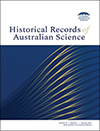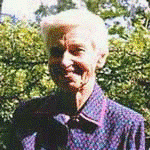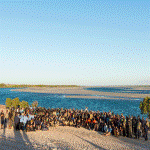HR25001 Full Text | HR25001PDF (623 KB) Open Access Article
Latest
These articles are the latest published in the journal. Historical Records of Australian Science is published under a continuous publication model. More information is available on our Continuous Publication page.
For more than seventy years, Professor Derek Denton investigated physiological and pathophysiological mechanisms regulating bodily salt and water balance. His groundbreaking work led to new treatments for patients suffering from fluid and electrolyte abnormalities. He played an important role in the establishment of the Howard Florey Institute of Experimental Physiology and Medicine, and was its founding Director (1971–89). On retiring as Director, he spent the final thirty years of his life studying the brain’s role in instinctive behaviours. Photograph by Sam Critchley.
HR24029 Abstract | HR24029 Full Text | HR24029PDF (1.8 MB) | HR24029Supplementary Material (654 KB) Open Access Article
HR24026Bibliography of the history of Australian science, no. 45, 2023/24
Robert (Bob) Crompton, a towering figure in low energy electron and ion physics in Australia, passed away in June 2022. He was known internationally for his seminal publications on swarm physics, atomic and molecular physics and gaseous electronics, and for his widely-read monograph with Sir Leonard Huxley on the subject of charged-particle transport. He was the recipient of many personal and professional accolades and awards for his contributions to science, science policy and the general community. Although born and educated in Adelaide, Crompton spent the majority of his long career at the Australian National University in Canberra in the Research School of Physics and Engineering
HR24028 Abstract | HR24028 Full Text | HR24028PDF (1.4 MB) | HR24028Supplementary Material (325 KB) Open Access Article
HR24023Robert Kirk: blood, genetics, race and rights in the twentieth century
Warning: This article discusses blood collecting in Aboriginal and Torres Strait Islander peoples. It also contains the image of an unnamed Aboriginal man who may be deceased.
It is not without justification that the collecting of blood for genetic analysis is frequently associated with race science, but it is not solely or inevitably so. This history of Robert Kirk, a British–Australian population geneticist, provides nuance to twentieth century blood science. Once problematic, Kirk’s legacy collection now returned to Indigenous control provides a promising future. Photograph: 01P-02-27, NCIG Archive, ANU, Canberra © Kirk family.
HR24023 Abstract | HR24023 Full Text | HR24023PDF (1.7 MB) Open Access Article
HR24022Gender diversity in Australian astronomy: the Astronomical Society of Australia 1966–2023
In 1966 the ‘marriage bar’ was removed for women working in the Commonwealth public service in Australia. During that year the Astronomical Society of Australia (ASA) was founded. We consider the changes in the diversity of astronomers working in Australia, including male/female ratios, since the formation of the ASA, and the development of gender equity strategies in astronomy. As well, we examine the experiences of Australian women astronomers and those of people from marginalised groups in astronomy. Photograph reproduced with permission from the IDEA ASA website.
HR24022 Abstract | HR24022 Full Text | HR24022PDF (2.1 MB) Open Access Article
HR24025The mysterious Dr Ferdinand von Sommer (~1800–49): Western Australia’s first government geologist
Dr Ferdinand von Sommer (~1800–49) served as Western Australia’s first government geologist and had ‘Mount Sommer’, north of Perth, named after him. Ferdinand also left behind three exceptional maps of his surveying and prospecting activities (1847–8) as well as reports to the government that can be considered impressive for their time and context, even by today’s standards. His scientific endeavours are worth re-discovering. Photograph of the author is by Matt Jelonek.
HR24025 Abstract | HR24025 Full Text | HR24025PDF (4 MB) Open Access Article
HR24021Roger Tory Peterson Down Under: an American’s influence on Australian birding field guides
Beyond helping us to identify birds, field guides sharpen our environmental awareness, deepen our connectedness to nature and foster a commitment to conservation. These facets of the field guide inspired the efforts of the leading American innovator of the genre, Roger Tory Peterson, as well as the Australian field guide authors who came under his influence in the 1950s and after. This article explains how Peterson helped shape Australian birding guides, and hence the relationship between birds and people in this country. It also recounts Peterson’s birdwatching adventures on his visits Down Under. Photograph courtesy of the Roger Tory Peterson Institute.
HR24021 Abstract | HR24021 Full Text | HR24021PDF (2.5 MB) Open Access Article
HR24020Spreading across the continent: the Astronomical Society of Australia 1966–2023
Australian astronomical research has changed drastically since the formation of the Astronomical Society of Australia in 1966. Here, we look at the changes in the context of the membership of the society and explore how the advent of new research facilities has led to changes in the number and geographical location of Australian astronomers. In particular, locating new radio telescopes in Western Australia has resulted in a more even spread of astronomers across the country. Photograph by Nick Lomb.
HR24020 Abstract | HR24020 Full Text | HR24020PDF (1.3 MB) Open Access Article
HR24019‘The Menace of Acclimatization’: the advent of ‘anekeitaxonomy’ in Australia
Acclimatisation—that is, the introduction of plants and animals to Australia from other parts of the world—is often seen as a nineteenth-century phenomenon. Focusing on wild bird species, this article argues, on the contrary, that acclimatisation continued well into the twentieth century. This article provides a cultural and political explanation for Australians’ belated turn against so-called ‘invasive species’ in the 1930s, ascribing this shift in attitudes to settler nationalism and xenophobia. Photograph by Alan Schmierer, via Wikimedia Commons.
HR24019 Abstract | HR24019 Full Text | HR24019PDF (888 KB) Open Access Article
HR24007_CO Full Text | HR24007_COPDF (680 KB) Open Access Article
HR24010Problems with Fenner and Marshall’s method of estimating myxoma virus virulence delayed a closer understanding of rabbit-virus coevolution
When myxoma virus was first released in Australia it quickly attenuated into less virulent variants while rabbits became increasingly resistant to myxomatosis. Rather than rabbits outstripping virus virulence, however, myxoma viruses have since been selected for renewed virulence which optimises their transmissibility. As well as benefitting the biological control of pest rabbits, this previously unrevealed chapter emphasises problems scientists had in reaching a consensus on how myxoma viruses and their host coevolved. Photograph courtesy of the Walter and Elisa Hall Institute of Medical Research.
HR24012Protecting Australia’s plant health: plant quarantine in an evolving biosecurity system
Global movement of plants and plant products brings risk of pests including weeds, invertebrates, and plant pathogens. Australia’s adaptive biosecurity system continues to mitigate these risks, using plant quarantine and modern diagnostics to isolate, detect and diagnose exotic pathogens. Photograph by Department of Agriculture, Fisheries and Forestry.
This article belongs to the collection: Plant Pathology in Australasia.
HR24012 Abstract | HR24012 Full Text | HR24012PDF (897 KB) Open Access Article
HR24006From internment in Trial Bay to exile in Berkeley: the German physicist Peter Pringsheim and his connection with Australia
Peter Pringsheim, professor of physics at the University of Berlin, has a unique connection with Australia. His attendance at the 1914 conference of the British Association for the Advancement of Science, held in Melbourne, coincided with the outbreak of World War 1, and he was interned as an enemy alien until July 1919. But with the support of key local scientists, Pringsheim used his internment to write a treatise on fluorescence and phosphorescence which established him as a world authority on this branch of atomic physics. Photograph: SP 421/4 4730 Peter Pringsheim, National Archives of Australia.
HR24006 Abstract | HR24006 Full Text | HR24006PDF (6.7 MB) Open Access Article
Dr Angus McEwan FAA FTSE who died on 5 September 2018, aged 81, was a renowned Australian fluid dynamicist, specialising in designing and conducting experimental studies in geophysical fluid dynamics, and providing outstanding leadership of national and international research programs in oceanography and meteorology. Image credit: Angus D. McEwan, personal communication.
HR24005 Abstract | HR24005 Full Text | HR24005PDF (1.4 MB) | HR24005Supplementary Material (380 KB) Open Access Article
David Albert Cooper AC (1949–2018) was an internationally renowned immunologist and HIV clinician who spearheaded Australia’s world-leading HIV response. In this article, his colleagues reflect on his contributions to HIV and infectious disease research, health policy, and the research institute he led for thirty-two years, the Kirby Institute.
HR23032 Abstract | HR23032 Full Text | HR23032PDF (1.9 MB) Open Access Article
Dr William (Bill) Roderick Blevin was an outstanding physicist and a renowned metrologist who brought great credit to metrology in Australia, particularly in the field of photometric and radiometric measurement. His research associated with an independent determination of the Stefan–Boltzmann constant led to a redefinition of the international unit for light intensity. His expertise and standing are recognised by the prominent role he played on international committees associated with the Metre Treaty and his leadership nationally. Photograph: Courtesy of Australian Academy of Science.
Jeremy Pickett-Heaps was a biologist whose acute observational powers were fed by a deep fascination for how cells work; he had an affinity for the myriad diversity of algae and other protists in general and for what they could teach us about all cells. He made fundamental discoveries in plant cell division and green algal phylogeny that developed into studies on cell division in general and he mastered time-lapse micro-cinematography to document the dynamic lives of cells. The resultant movies and his enthusiastic teaching introduced many to the wonders of microscopic life. Photographer unknown.
HR24017 Abstract | HR24017 Full Text | HR24017PDF (4.4 MB) | HR24017Supplementary Material (276 KB) Open Access Article
HR24013Guest editor’s page: the path to food security in Australia through better plant disease management
HR24013 Full Text | HR24013PDF (716 KB) Open Access Article
Ross Taylor, an internationally renowned geochemist and planetary scientist and a Companion of the Order of Australia, spent most of his 65-year career at the Australian National University. His laboratory expertise was in trace element geochemistry and he made numerous major discoveries about the nature of the Moon, Earth’s continents, tektites and solar system evolution. In 1969, he carried out the first-ever geochemical analysis of a lunar rock (Apollo 11) at the NASA Lunar Receiving Laboratory in Houston. Photograph credit: Australian Academy of Science.
HR24008‘Where does a female plant pathologist work?’: Gretna Weste (née Parkin) AM DSc
Gretna Weste was a woman plant pathologist who pioneered research on dieback, a devastating new disease of forests in southern Australia, in the late twentieth century. Weste’s research was foundational in the recognition of dieback disease as a Key Threatening Process for Australia’s natural biodiversity in 2000. Her career illustrates the significant gender-based obstacles faced by women scientists in Australia, and the stoic strength demonstrated by Weste. Photographer unknown.
HR24008 Abstract | HR24008 Full Text | HR24008PDF (1.3 MB) Open Access Article
This paper is a biographical note on the life and achievements of Professor Gavin Brown. Gavin was a distinguished mathematician who became vice chancellor of both the University of Sydney and the University of Adelaide. He made a significant contribution to his subject area and to the Australian academic scene. Source: Australian Academy of Science archives.
HR23024 Abstract | HR23024 Full Text | HR23024PDF (1.5 MB) | HR23024Supplementary Material (932 KB) Open Access Article
HR24011Northern Australia Quarantine Strategy plant health surveys: over thirty years of a globally unique on- and off-shore solution to island nation biosecurity challenges
 , Lynne M. Jones, Harshitsinh A. Vala, Bradley Pease, David Cann, Pere Kokoa and Francis T. Tsatsia
, Lynne M. Jones, Harshitsinh A. Vala, Bradley Pease, David Cann, Pere Kokoa and Francis T. Tsatsia
This is the story of how the Australian Government has been protecting Australia’s remote northern coastline from biosecurity invasions from neighbouring countries. It is a story of boots on the ground plant health surveillance across Australia’s north and also over the horizon, in the countries that lie so close to our northern shore. Key to success has been collaborative field work overseas, with biosecurity scientists of Indonesia, Timor Leste, Papua New Guinea and Solomon Islands. Photograph by Kerry Trapnell.
HR24011 Abstract | HR24011 Full Text | HR24011PDF (2.8 MB) | HR24011Supplementary Material (223 KB) Open Access Article
After graduating in medicine at the University of Queensland, completing his PhD at the Kanematsu Institute in Sydney, and postdoctoral studies in Germany, in 1966 John Atherton Young he joined the department of physiology at the University of Sydney where his research on the physiology of epithelial ducts brought him international recognition as a leader in the field. He made significant contributions to university governance and professional societies and respected as a man of great culture, a witty conversationalist, a great scientist.
HR24007 Abstract | HR24007 Full Text | HR24007PDF (1.6 MB) | HR24007Corrigendum (675 KB) | HR24007Supplementary Material (608 KB) Open Access Article
Just Accepted
These articles have been peer reviewed and accepted for publication. They are still in production and have not been edited, so may differ from the final published form.
Setting priorities for publicly funded research: the CSIRO Priorities Method
 and Tom Spurling
and Tom Spurling
Most Read
The Most Read ranking is based on the number of downloads in the last 60 days from papers published on the CSIRO PUBLISHING website within the last 12 months. Usage statistics are updated daily.
-
Protecting Australia’s plant health: plant quarantine in an evolving biosecurity system
Historical Records of Australian Science 36 (1) -
The untold history of banana bunchy top disease
Historical Records of Australian Science 35 (2) -
Northern Australia Quarantine Strategy plant health surveys: over thirty years of a globally unique on- and off-shore solution to island nation biosecurity challenges
Historical Records of Australian Science 35 (2) -
A matter of where and when—the appearance of Late Blight of potato in Australia
Historical Records of Australian Science 35 (2) -
The mysterious Dr Ferdinand von Sommer (~1800–49): Western Australia’s first government geologist
Historical Records of Australian Science 36 (1) -
Gender diversity in Australian astronomy: the Astronomical Society of Australia 1966–2023
Historical Records of Australian Science 36 (1) -
Spreading across the continent: the Astronomical Society of Australia 1966–2023
Historical Records of Australian Science 36 (1) -
Guest editor’s page: the path to food security in Australia through better plant disease management
Historical Records of Australian Science 35 (2) -
Roger Tory Peterson Down Under: an American’s influence on Australian birding field guides
Historical Records of Australian Science 36 (1) -
‘The Menace of Acclimatization’: the advent of ‘anekeitaxonomy’ in Australia
Historical Records of Australian Science 36 (1) -
Robert Kirk: blood, genetics, race and rights in the twentieth century
Historical Records of Australian Science 36 (1) -
Robert Woodhouse Crompton 1926–2022
Historical Records of Australian Science 36 (1) -
From internment in Trial Bay to exile in Berkeley: the German physicist Peter Pringsheim and his connection with Australia
Historical Records of Australian Science 36 (1) -
Bibliography of the history of Australian science, no. 45, 2023/24
Historical Records of Australian Science 36 (1)Compiled by Helen M. Cohn -
-
Problems with Fenner and Marshall’s method of estimating myxoma virus virulence delayed a closer understanding of rabbit-virus coevolution
Historical Records of Australian Science 36 (1)
Collections
Collections are a curation of articles relevant to a topical research area
This Historical Records of Australian Science Collection has been curated in support of the 2023 conference of the Australasian Association for the History, Philosophy and Social Studies of Science.
Collection Editor
Dr. Martin Bush, Senior Research Fellow, Historical and Philosophical Studies
Last Updated: 20 Nov 2023
This Collection acknowledges the Hundred Year anniversary of the Australian Coral Reef Society (ACRS), which first met as the Great Barrier Reef Committee in Brisbane on 12th September 1922. The collection reflects on many years of dedication of reef scientists, members and councillors to advancing our understanding of, and protecting, coral reefs.
Collection Editor
Dr Sarah Hamylton, President, Australian Coral Reef Society
Last Updated: 18 Nov 2022
The articles in this Collection of Historical Records of Australian Science are a diverse look at the history of archaeology in Australasia and the Pacific.
Collection Editors
Hilary Howes and Matthew Spriggs
Last Updated: 27 Oct 2021
This Collection supports the United Nations General Assembly’s declaration of 2020 as the International Year of Plant Health (IYPH) and exemplifies the quality of the work of Australian scientists. The articles discuss both processes that improve plant health and the careers of individual scientists who have played leading roles in research, education, policy and advocacy.
Collection Editors Sara Maroske and Ian Rae
Last Updated: 27 May 2020
The Australian Academy of Science, in partnership with the National Museum of Australia, awards the Mike Smith Prize to recognise young scholars who are undertaking original research in the fields of the history of Australian science or Australian environmental history. Six of these articles are reproduced in this Collection, to alert our readers to the positive outcomes for entrants, participating institutions and the disciplines of the history of Australian science and Australian environmental history.
Last Updated: 26 Sep 2019
In this Collection, published in association with the 4S Conference in Sydney, we offer a selection of articles that reveal how Australian historians have responded to transnational issues such as the spread of Western science, climate change, and communicating the history of science.
Last Updated: 19 Jul 2018
As a contribution to the 2017 Science in Australia Gender Equity (SAGE) symposium, this Collection of the Academy’s journal Historical Records of Australian Science brings you memoirs of six pioneering female Fellows, and articles on Olive Pink (central Australian anthropologist and gardener), and two women chemists (Ruth Gall and Jean Youatt).
Collection Editors Sara Maroske and Ian Rae
Last Updated: 04 Aug 2017
























